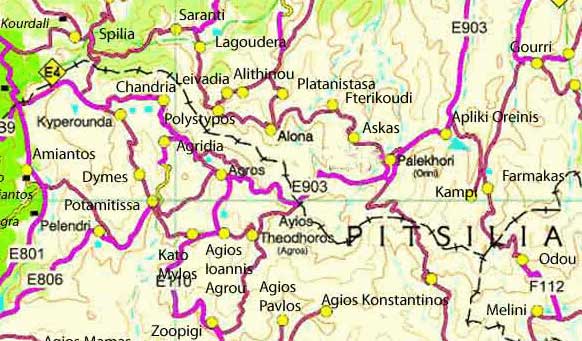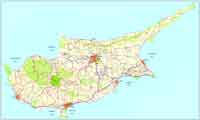|
|
Askas, Cyprus
Askas, Photo: Alexandros Daskalakis (Αλέξανδρος Δασκαλάκης) Askas (Greek: ) is a small village in Pitsilia region in the Nicosia District on the island of Cyprus. It is positioned 1000 metres above sea level on the north side of the Troodos mountain range, at the foot of Mount Papoutsa. Kyriakos Argyrou is the president of the Community Council of Askas. Askas, like all the villages of the area, has gone trough fluctuations of its population. In 1881 its inhabitants numbered 142, increasing to 333 in 1911, and to 439 in 1946. In 1960 the population decreases to 363, and to 321 in 1982. In the 2001 census the village numbered 187 inhabitants. The village lies close to the Nicosia -- Limassol administrative borders, having a distance of about 50 kilometres from Nicosia and just two kilometres west of Palaichori, receiving an average annual rainfall of about 800 millimetres; mainly vines of the wine-making variety, vegetables, hazel, walnut, and olive trees, fruit-trees, almond trees, and forage plants are cultivated in its region. The village is connected via road to Palaichori in the east and from there on to Nicosia, to Agros in the south-west, and to Alona, Polystypos, and Kyperounta in the west. Like all the villages, it has its character and peculiarities. However, very intense characteristics appear here that lend to it a unique picturesque quality. With one house adjacent to the other and its narrow, winding alleys buried amidst towering, stone-made walls, it looks like a swallow's nest stuck on the rock. The houses, apart from the recent ones, are traditionally built entirely with local materials: the stone, the clay, and the pinewood from the surrounding mountains. The roofs have tiles, all "kneaded" and "baked" locally. The village's history is lost in the depths of time. No one knows exactly when the village was built and when it was first inhabited. One specific testimony is a date found on the front of an internal door, in the basement of Theofanis's house where the earthenware jars were kept. It was covered with a thin layer of clay. However, one day someone leaned on it with his hand and the clay fell off, revealing the date 1381. This indicates that the village was in existence during the Frank Domination era, without that meaning it did not exist before that. There are two churches in the village. One is dedicated to the Holy Baptist (John) and the other of the Holy Cross. There is also the country church of "Agia Christina" that today is called the country church of "Agia Paraskevi". The village -under its present name -is not included in the list of Lusignan - Venetian feuds and royal estates of Mas Latri. However, it is most probable that the "Asta" settlement that is found marked in the Venetian maps is Askas. According to one version, the village's name is due to its first settler who was a skin-bag maker. Another version reports that it took its name from a mediaeval family of nobles that was surnamed Askas. The excellent position of the village, its amazing climate, and the wonderful natural environment that surrounds it, are the things that will cause the admiration of the visitor, engraving on his/her memory the uniqueness of this small but picturesque village. Tour The first thing that you feel once you arrive at Askas is the change of climate. The climate is dry and cool and the air is clean. It can be seen from far away that the nature in this region has created the whole landscape with love and high spirits. Advancing toward the village, you will face the "Pernia" restaurant and the park that is dedicated to the community's missing Person, as well as the Missing Person's "Christakis Ioannou" monument. Here you can enjoy your food, having the open horizon in the north as background on one side, extending up to Pentadaktylos, and -in the west -an endless range of hazels, transferring you into a magical world with their dark, green colour. Walking under the thick leafage of the hazels and amongst the gargling, running waters, you will be infatuated with the singing of the nightingales, the swallows, and the other birds; you will feel the calmness and the serenity that only nature can give to you. Looking towards the village, you will face the Elementary School, which seems as a Parthenon that towers over the village. Entering the village from the east side, you can visit the church of "Timios Prodromos" (Holy Baptist). The church was built in the 14th century. It is made in the style of a Basilica and in it you can admire its gold-plated icon screen and its remarkable hagiographies (icons of saints). Its steeple is made of chiselled stone and the bell is considered as one of the three most beautiful bells in Cyprus. In the church's yard stands the village's reconditioned, old olive-press. Here you can observe the way with which our ancestors produced oil. Moving on westerly toward the village, you find the CTO plaza. Here you can rest in the shadow of the towering hazels and enjoy nature in all its glory. Further on you will come across the old Police Station, which is also reconditioned. It is one of the oldest Police Stations in Cyprus, a sign that the village had several inhabitants in previous times. Arriving at the village's centre, you will find the old fountain of the village. It lies next to the renovated House of Evgenia that operates in the context of Agro-tourism. Here you can admire the exquisite architecture of this building and -if you want -spend the night there. The hospitality in this house is one of a kind. In the village's upper side there is the coffee-house where one can rest from walking and enjoy his / her coffee. Next to it stands the village's supermarket. Ascending the paved, narrow alleys and admiring the unique and remarkable architecture of the village, you come across the village's second church, which is dedicated to the Holy Cross ("Timios Stavros"). The church was made in the 11th century in the Basilica style and the unique icon of St. George can be found extant in the middle of the Sanctuary. Next to the church stands the first Girl's School to ever operate in Cyprus. It now is reconditioned and houses the Community Council's offices and the community's Health Centre. Between the Church and the Girl's School lies the paved plaza of the Holy Cross. A bit further outside the village you will find the country church of "Agia Christina", which was later renamed as church of "Agia Paraskevi". It is a very old country church and it is partly illustrated. Next to it is the excursion site of "Agia Paraskevi". The entire village gathers there on Easter Tuesday for the roasting of the "souvla" (meat skewer). At the village's lower end there is the oldest spring, virtually ridden with the green of the trees. Its ice-cold water refreshes the visitor. Ending our little tour in Askas, you will depart loaded with all sorts of emotions. The serenity that can be found in the area, the amazing climate, the green of the trees with which nature has so masterly decorated the area with, the village's unique folkloric architecture, and the inhabitants' hospitality will -forever -remain engraved in your memory. Links Source ---
Retrieved from "http://en.wikipedia.org/"
 |
|
||||||||||||||



